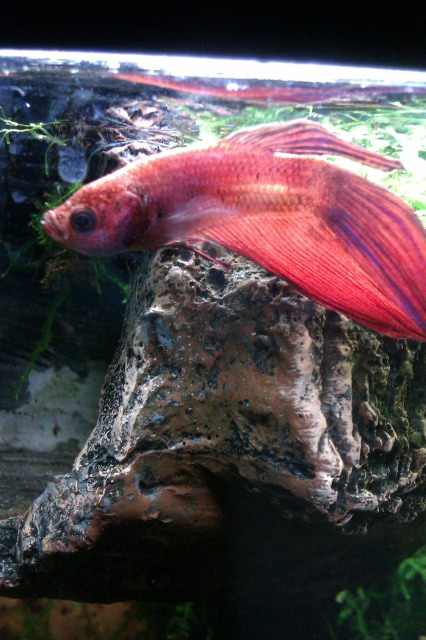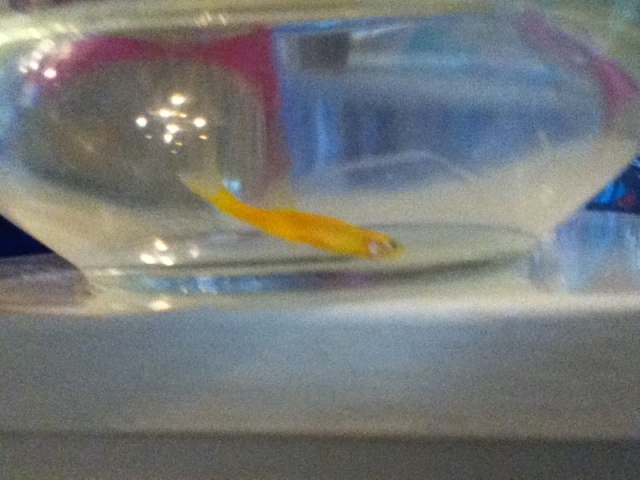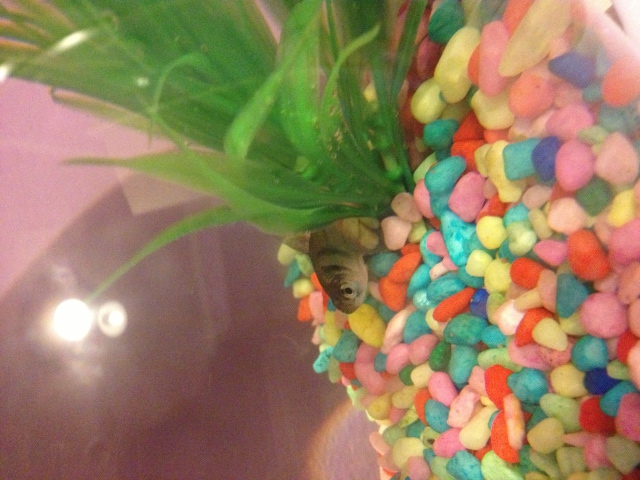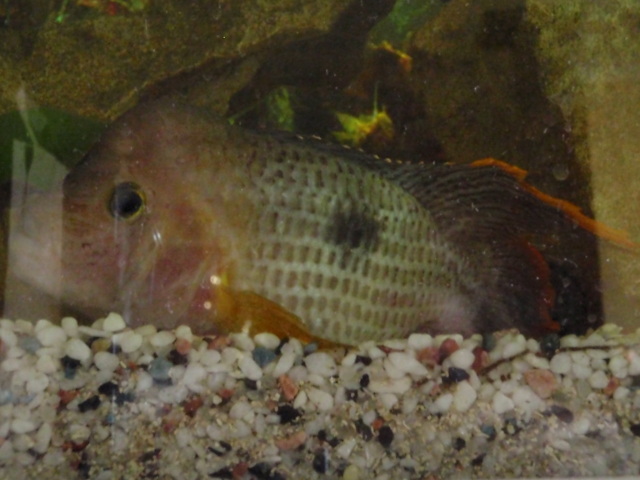QuestionQUESTION: Hello Expert,
Thank you for helping me with my fish.
I currently have three goldfish. I am uncertain as to exactly which type they are, but I think they may be panda moor goldfish. One of my goldfish has recently fallen ill, but the other two are perfectly healthy and doing fine. This fish was breathing heavily last week. I went away on vacation over the weekend and returned to find him floating upside down on the surface of the water. He is still breathing and can use his fins to swim a little bit, but is unable to control his depth or buoyancy. Additionally, his fins look as if they are beginning to fray. Unfortunately, due to his inability to swim properly, he was sucked into the filter pipe where he sustained a large, red contusion from the suction pressure. I have removed him to a hospital tank and an currently applying fungus cure to the water to help his fins recover. I was told that he may have swim bladder problems, and I have kept him on a fast for the past 36 hours, but he is not improving. Has he been properly diagnosed? How can I help him? Is there anything I can do to assist with his recovery or help mend his contusion? Thank you for your help!
-Shannon
ANSWER: i wouldnt treat with fungus care...he doesnt have that...the fungus disease is where they have a sort of slime coating on them...he sounds like he has many problems but the fraying fins is probery fin rot not fungus..if you treat hin wrongly he will die so stop that treatment and do a water change (about 30% once a day for 2 days)
also..to help me answer and try and diognose correctly what are ALL his symptoms...
does his scales look like there popping off? is he really fat or bloated looking?? does he have red gills..i know he has torn fins..that could either be fin rot or ammonia posioning..but other symptoms will help me determine which one it is...
if his symptoms are these:
Erratic Swimming Position
Loss of equilibrium
Fish will be unable to maintain buoyancy
then he probably has a swim bladder disease...
Swim Bladder Disease General Description
Swim bladder disease is a multifactorial illness which primarily affects ornamental goldfish which have globoid body shapes, like orandas, ryukins, and fantails. It most often presents as a fish which floats at the surface, or a fish which stays on the bottom and doesn't seem to be able to easily rise. A fish which has normal buoyancy but is listing to one side or the other often does not have swim bladder disease, but may have other diseases.
Swim Bladder Disease Treatments
This is a problem more common in fancy goldfish, and there is no cure for it. Feeding medicated food (see bottom of page), adding salt to the tank, feeding peas, and raising the temperature to 76 degrees may help but only for a short time. Eventually the fish may be unable to eat and will have to be euthanized.
Feed your fish a couple of peas. That's right, peas. Just get some frozen peas, thaw them, and feed them to your fish. A professor of fish medicine at N.C. State College of Veterinary Medicine has done this in several cases with very good results. He thinks that the peas somehow encourage destruction of the impaction. No hard scientific data yet, but it's worth a try.
Fast your fish for a couple of days. Withhold all food for three or four days, and sometimes this alone will break up the impaction and return things to normal. Most fish can go a week to ten days without food and be just fine.
Periodic aspiration of the swim bladder works very well. Basically, you stick a needle in the swim bladder and suck out some of the air. Not something to be entered into lightly, but does work well. This is not a cure, but a successful treatment. The head veterinarian at the Baltimore Aquarium prefers this method.
Swim Bladder Disease Prevention
As always, the golden rule of fish disease is Water Quality. If swim bladder disease does have an infectious cause, your fish will be better able to resist this infection (and others) if your water quality is good. Regular water changes and water testing are a must.
Pre-soak your flake or pelleted food. This will allow expansion to occur prior to the fish eating it, and will lessen the chance of impaction.
Even better, switch to a gel-based food or other food source, i.e. frozen or live food.
if not..please tell me ALL his symptoms and ill help you save your fishy!!
---------- FOLLOW-UP ----------
QUESTION: Thank you so very much for relaying all of your advice in such a timely fashion!
Per your request I am going to list his symptoms:
1) No scales popping off. He does not look abnormally fat or bloated. No red gills. The very tips of some of his fins look to be fraying and slightly deteriorating. Those fins that are affects appear to have very small white cottony fuzz on them. However, no all of the fins have been affected.
2) In terms of his ability to swim: his tail is slightly bent towards the left. He has an almost inability to maintain buoyancy. Although, I did just see him swim to the bottom which is a marked improvement. He usually rests at the top of the tank and looks completely lethargic. He appears to have a loss of equilibrium. I have placed long plants in the hospital tank to help provide gentle support and to help keep him completely under the water so that he does not dry out.
3) He appears to be quite weak. Does not really attempt to swim. Also, his breathing appears to be more rapid than usual.
4) Since removing him from the filter he has a large contusion. It is red, as though the blood has been sucked up towards his skin/scales. However, this has reduced slowly since removing him from the filter.
I will do a water change and stop the fungus treatment if you think it best. I will also feed him peas to help the digestion process. Should I fast him for a few days before feeding him peas or should I feed him peas now and then fast him? If it is in fact fin rot, how can I help him? Could this be caused by something that will threaten the other fish? I have done extensive water changes for the healthy fish after removing the sick fish.
ANSWER: sorry..if the fins have white fuzzy stuff then it may indeed be a fungal infection...i would do a water change in the main tank too just incase they get it...it wont harm them and its better to be safe than sorry
symptoms of finrot are mainly:
Fins turn whitish and die back
Jagged Fins
Fin look like they were ripped off
Fish is not eating
and stymptoms of velvet (a sorft of fungal infection)
Fine grey-gold to whitish 'dust' on the body
Very rapid gill movement
Scratching or flashing
Clamping of the fins
Very similar it ICH
and symptoms of a more comman fungal infection:
Loss of appetite
White spots on mouth, scales, and fins
Cottony growth on mouth
Fins disintegrate beginning at the edges
Looks like a small cotton ball
if you think he has any of these i can let you know treatments for them..but it sounds like the main problem would be his swim bladder, maybe just not as bad as the description i gave you is of the worst cases..
about the peas...take off there shells as fish dont eat them...feed him peas now if you have already fasted him..if you feed peas you dont need to fast..they releive constipation and saved a fish of mine that was going to die..there was no doubt about it...i just fed him pea's teice a day and nothing else...he wanted them but couldnt reach them so i ended up having to take it right to his mouth as he couldnt swim properly to get them...that fish lived for 2 years after and passed away due to a spinal defect he had had for 3 years...(it was from use of treatments that wernt needed) it mucked up his growth so i rescued him if you like lol..but yeah..i would feed peas now (sorru for getting side tracked there)
---------- FOLLOW-UP ----------
QUESTION: Thank you so so much!
I will go to the store and buy some peas now to feed him.
As for the fin issue, his symptoms seem to fall in line with these symptoms you stated:
symptoms of a more common fungal infection:
Loss of appetite
White spots on mouth, scales, and fins
Cottony growth on mouth
Fins disintegrate beginning at the edges
Looks like a small cotton ball
Is the fungus cure in the water the best way to help cure this? Do you have any other suggestions? Thank you for being so helpful! I really think with proper treatment he'll be okay!!
Answeryeah i think your fungal treatment should treat that, but if you getchance, stop by at a petstore and have a look at some treatments that are made for those symptoms..just so it helps..those are the symptoms of a disease called cotton mouth..here is some treatment advice:
Cotton Mouth General Description
Mouth Fungus is so called because it looks like a fungus attack of the mouth. It is actually caused from the bacterium Chondrococcus columnaris. It shows up first as a gray or white line around the lips and later as short tufts sprouting from the mouth like fungus. The toxins produced and the inability to eat will be fatal unless treated at an early stage.
Cotton Mouth Treatments
Hard to treat, but not impossible. Like any disease best caught early. There are commercial products available to treat cotton mouth. Also change the water daily 20% and use a regular dose of salt in your tank.
Cotton Mouth Prevention
Usually this comes in with the fish directly from the pet store, or shipment. Because the bacteria thrive on organic wastes, it can be controlled by regular water changes and vacuuming of the gravel. Proper diet and maintaining good water quality in general will keep the fish from being stressed and therefore susceptible to infection.
good luck with your fish and im always happy to help you if you need it!

 Goldfish Issue
Question
Goldfish Image
Hi. My fish is a goldfis
Goldfish Issue
Question
Goldfish Image
Hi. My fish is a goldfis
 Betta Health Issues
Question
Close-up of betta whole body shot
Betta Health Issues
Question
Close-up of betta whole body shot
 glofish tail elongated
Questionsick glofish 2
sick glofish
QUEST
glofish tail elongated
Questionsick glofish 2
sick glofish
QUEST
 Black widow (tetra)
Question
Tetra
Hi there,
I am a very concerned f
Black widow (tetra)
Question
Tetra
Hi there,
I am a very concerned f
 Sinking Green Terror
QuestionGreen Terror Sitting
QUESTION: Hi Ron,
Sinking Green Terror
QuestionGreen Terror Sitting
QUESTION: Hi Ron,